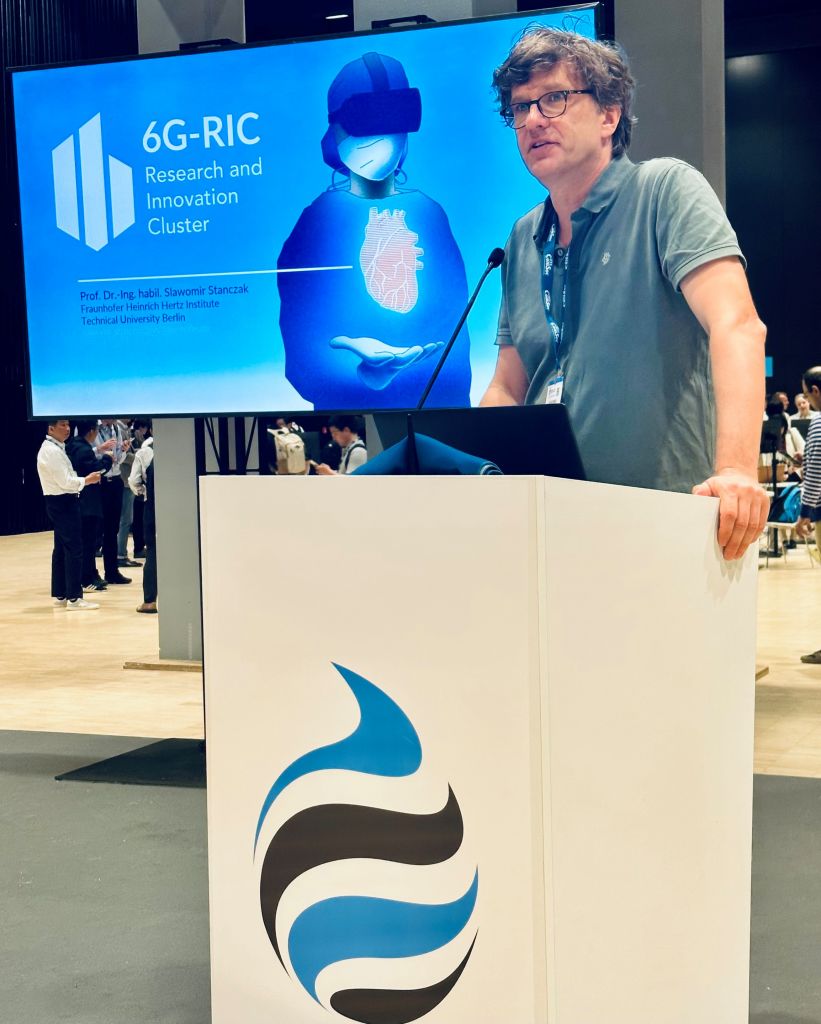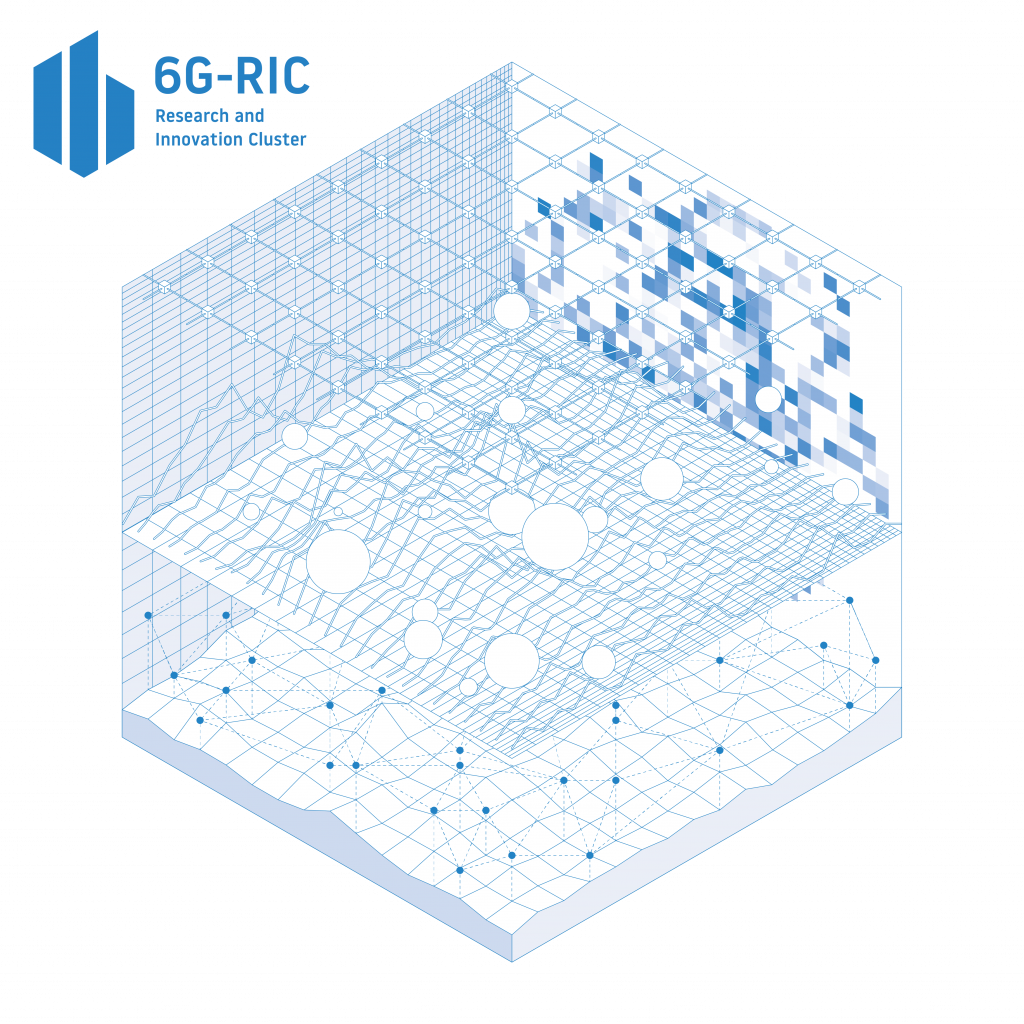Forschungs-Hub "6G-RIC"
Research and Innovation for Sustainable and Secure 6G Technologies
Motivation
Das 6G Research and Innovation Cluster (6G-RIC) ist ein Forschungszentrum, das die wissenschaftlichen und technischen Grundlagen für die nächste Generation des Mobilfunks (6G) über alle Technologieebenen hinweg schaffen soll, vom Funkzugang über die Kernnetze bis hin zu den Glasfaser-Transportnetzen. 6G-RIC konzentriert sich auf die Erforschung und Entwicklung einer sicheren, flexiblen und offenen Kommunikationsinfrastruktur als Basis für eine erfolgreiche Digitalisierung in Wirtschaft und Gesellschaft in allen Bereichen.
6G-RIC wird durch eine interdisziplinäre und koordinierte Zusammenarbeit von insgesamt 32 Forschungsgruppen aus 20 Universitäten und Forschungseinrichtungen und durch mehr als 60 assoziierte Partnerschaften aus Wissenschaft, Wirtschaft und Verwaltung sowie einem Expertenbeirat begleitet. Durch Spitzenforschung und internationale Vernetzung will das 6G-RIC dazu beitragen, dass Deutschland und Europa beim Ausbau nachhaltiger 6G-Technologien weltweit führend sind.
Wir können unser Fachwissen im Bereich Mobilfunk, künstliche Intelligenz sowie optische Datenübertragung und -kompression von der Grundlagenforschung bis zur praktischen Umsetzung in das 6G-RIC-Konsortium einbringen. Durch die Zusammenarbeit mit erfahrenen Partnern im Forschungs-Hub 6G-RIC möchten wir Deutschlands Führungsposition im Bereich 6G weiter ausbauen und uns als Vorreiter in der Entwicklung zukünftiger Kommunikationstechnologien etablieren.
Prof. Dr.-Ing. Slawomir Stanczak, Koordinator des Hubs
Ziele und Vorgehen
Das Herzstück von 6G-RIC sind sechs technische Innovationsbereiche (TIAs), die als Technologietreiber für 6G dienen. Jeder TIA ist mit spezifischen Forschungsherausforderungen verbunden, deren Lösung im Mittelpunkt der 6G-RIC-Forschungsagenda steht.
Im Einzelnen werden folgende technologische Innovationsfelder betrachtet: die Erschließung höchster Frequenzen im Sub-Terahertz-Bereich (bis zu 300 GHz) für mobile Anwendungen durch effiziente Transceiver-Technologien (Sub-THz Mobile Access); die Erforschung und Entwicklung von intelligenten Oberflächen zur Anpassung und Optimierung der Funkumgebung (Intelligent Radio Environments); die Konvergenz von Radar-Sensing-Anwendungen und Kommunikation (Network as a Sensor); eine zielorientierte Vereinheitlichung der Datengenerierung, Informationsübertragung und -nutzung (6G Connectivity); Integration von Kommunikationssicherheit und Datenschutz als Bestandteil des Systemdesigns (Post-Quantum Security by Design) sowie virtualisierte und disaggregierte 6G-Netze (Autonomous, Convergent Networks) durch Abstraktionen der Hardware- und Softwarekomponenten.
Dabei spielen Energieeffizienz und Sicherheit als horizontale, alle untersuchten Technologien übergreifende Aspekte eine führende Rolle.
Innovationen und Perspektiven
Im Rahmen von 6G-RIC sollen Schlüsseltechnologien innerhalb von Ende-zu-Ende-Demonstrationen im Real-Labor evaluiert werden. Es geht darum, eine offene Infrastruktur zu etablieren, die es KMU und Start-ups ermöglicht, Technologiekomponenten zu entwickeln und unter kontrollierten Bedingungen mit modernster Messtechnik im Labor und unter realen Bedingungen zu evaluieren. Durch die frühzeitige Einbindung von Fördergebern soll eine Verstetigung der Testinfrastruktur erreicht werden. Mobilfunk-Innovationen sollen somit mittel- und langfristig unterstützt werden.
6G-RIC wird mit 70 Millionen Euro über eine Laufzeit von vier Jahren (2021–2025) vom Bundesministerium für Bildung und Forschung (BMBF) gefördert.
Um die Forschungsergebnisse nachhaltig zu verwerten, soll 6G-RIC als Kompetenzzentrum dauerhaft etabliert werden. Als herausragender Standort für Wirtschaft und Wissenschaft bietet Berlin hier die idealen Bedingungen. Durch interdisziplinäre Zusammenarbeit sollen im Rahmen dieser Verstetigung 6G-basierte Anwendungen in enger Zusammenarbeit mit Industriepartnern entwickelt werden, um die Gesellschaft nachhaltig zu transformieren. Hierbei liegt der Schwerpunkt neben Grundlagenforschung auf Anwendungen im Bereich Gesundheit, Automotive, Robotik und KI. Zusätzlich ist die Unterstützung und Förderung von Start-ups im Rahmen eines Inkubator Programms von zentraler Bedeutung.



Partner
- Christian-Albrechts-Universität zu Kiel
- Deutsches Zentrum für Luft- und Raumfahrt e. V. (DLR), Institut für Kommunikation und Navigation, Weßling
- Eberhard Karls Universität Tübingen
- Ferdinand-Braun-Institut gGmbH, Leibniz-Institut für Höchstfrequenztechnik, Berlin
- Fraunhofer IAF, Freiburg
- Fraunhofer IIS, Nürnberg
- Fraunhofer FOKUS, Berlin
- Fraunhofer IZM, Berlin
- Freie Universität Berlin
- Friedrich-Alexander-Universität Erlangen-Nürnberg
- Humboldt-Universität zu Berlin
- IHP GmbH –Leibniz-Institut für innovative Mikroelektronik, Frankfurt (Oder)
- Max-Planck-Institut für Informatik, Saarbrücken
- Rheinisch-Westfälische Technische Hochschule Aachen
- Technische Universität Berlin
- Technische Universität Braunschweig
- Technische Universität Chemnitz
- Technische Universität Darmstadt
- Universität Passau